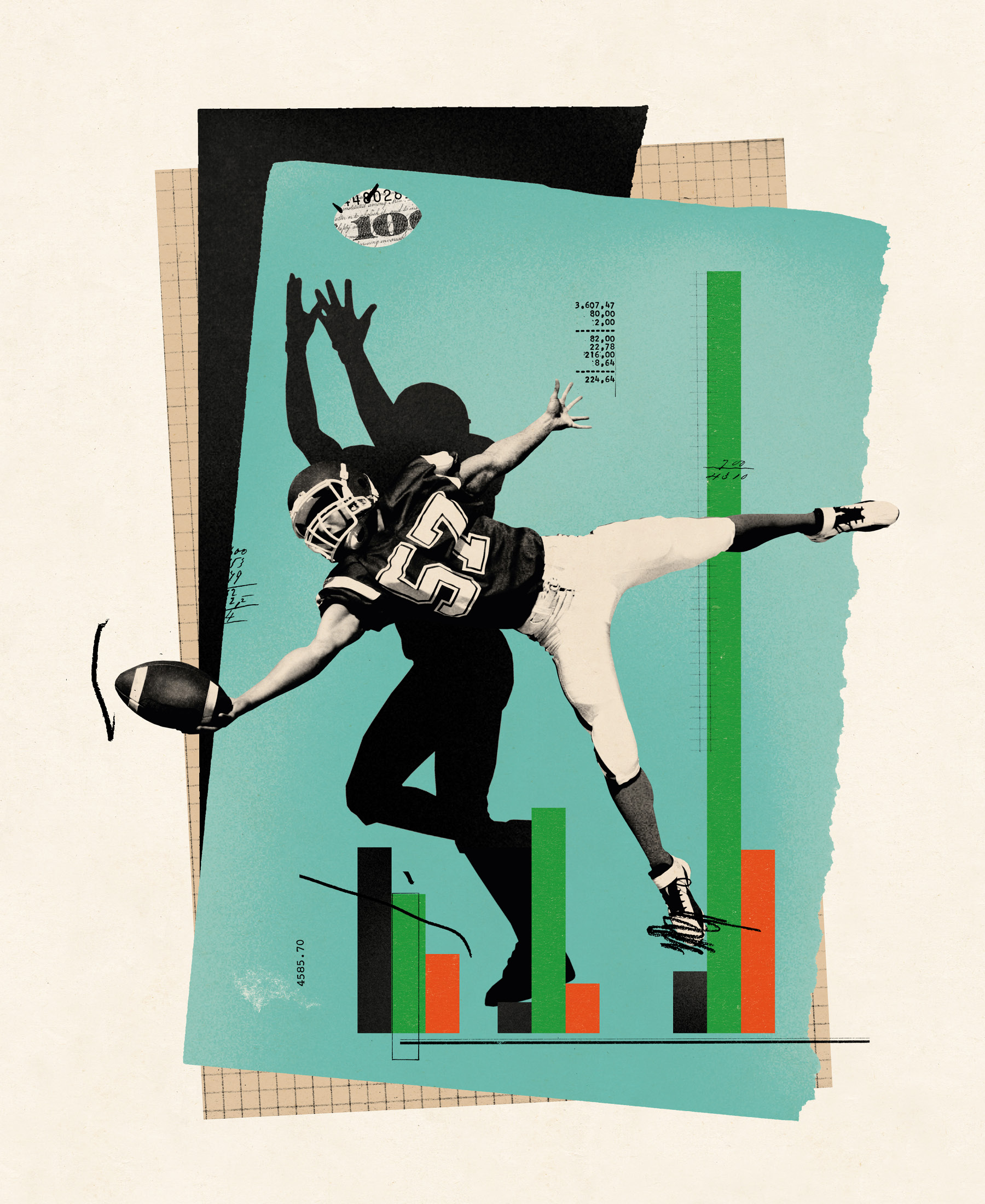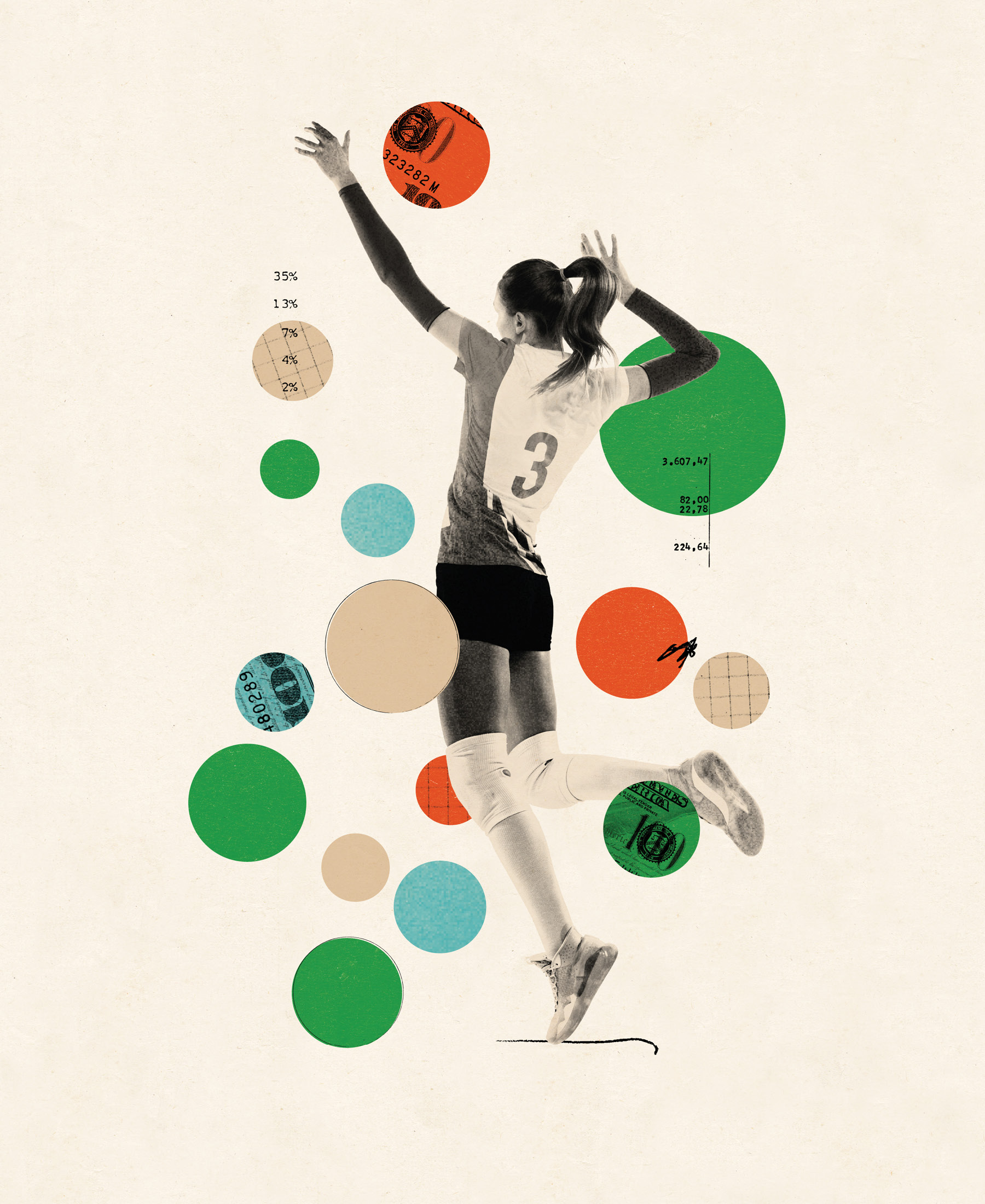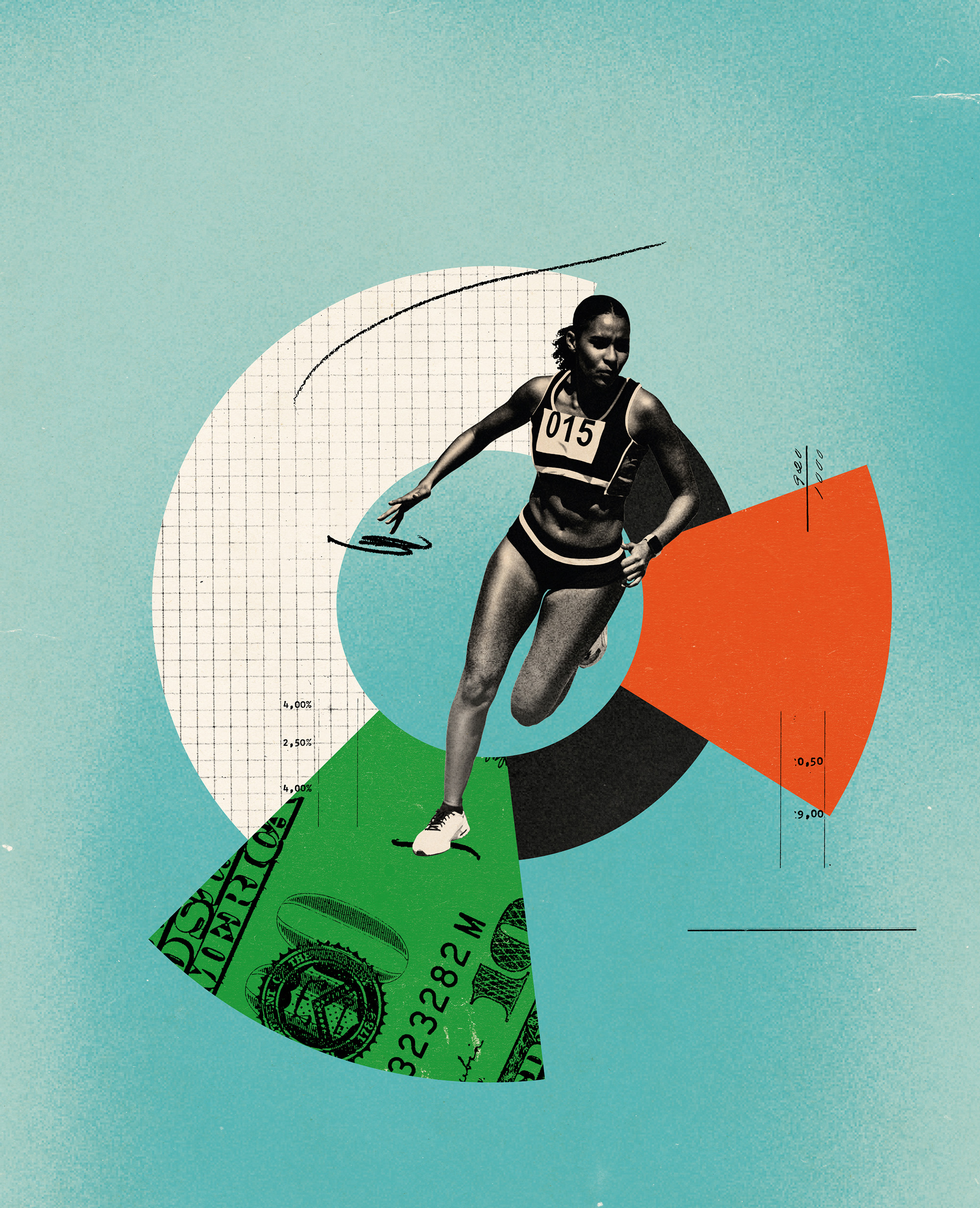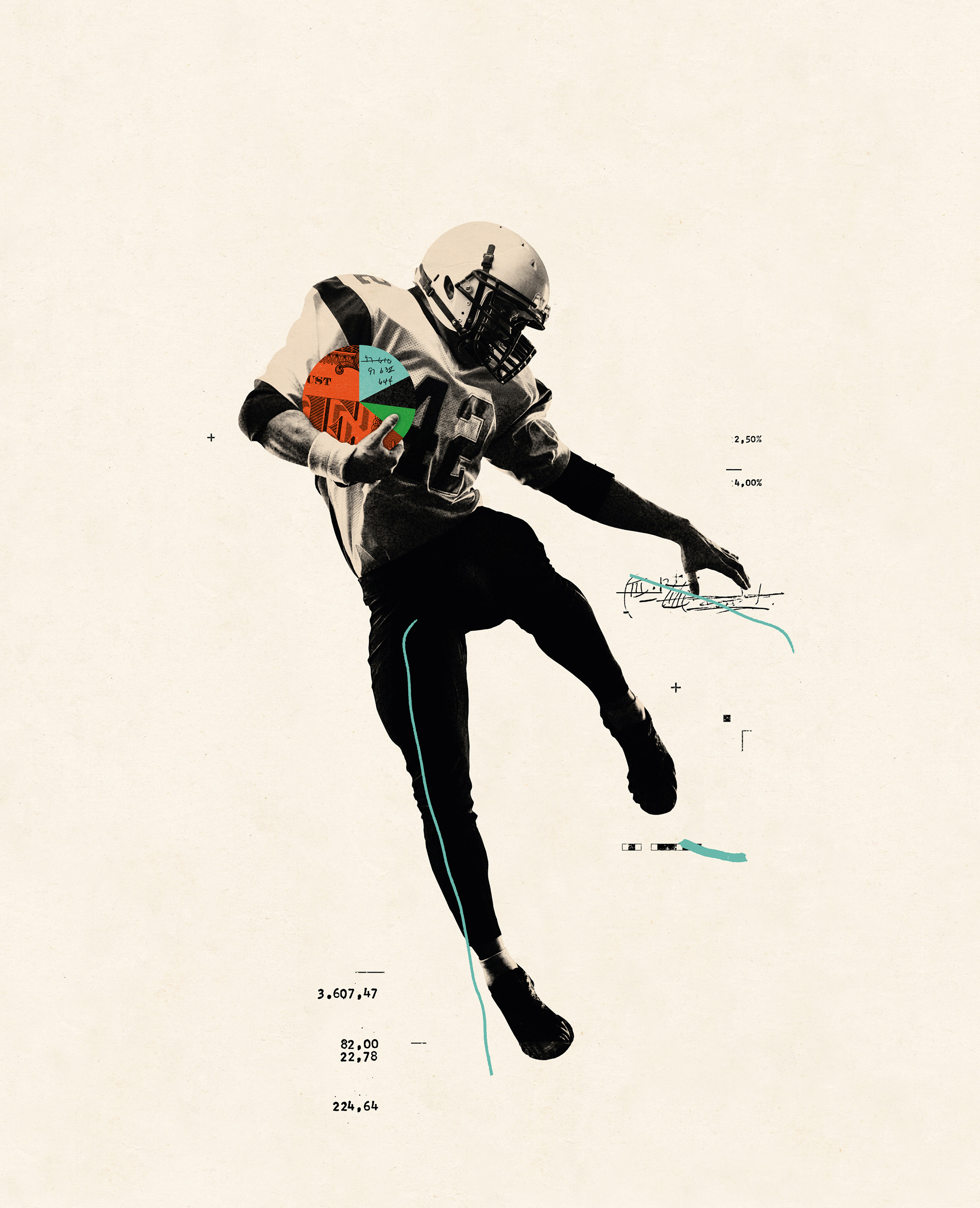In the changing world of college athletics, money has a front row seat, and lawyers are the new playmakers.
Written by Joe Nick Patoski
Illustration by Cristiana Couceiro

How NIL is changing the game for college sports.
Anyone watching television, listening to radio, reading newspapers and magazines, or scrolling through social media has noticed: Quinn Ewers and Arch Manning are everywhere. The two Texas Longhorn quarterbacks talk up video games, soft drinks, streaming services, Aston-Martins, private jets, and personal injury law firms.
Ewers and Manning are among the first wave of high-profile college athletes getting paid for their name, image, and likeness (NIL). Among college football players, Ewers ranks fourth in the NIL marketplace, earning $2.1 million as of September 2024, according to ON3 Sports, a media and technology company that focuses on NIL. Manning is ranked second, having already generated $3.2 million in NIL.
For most of its 118 years of existence, the National Collegiate Athletic Association (NCAA) – the governing body for college sports – held the amateur athlete as its noble ideal. Money or other incentives should not taint games nor the competitors participating in those games, or so the story went.

Not anymore.
In 2021, the United States Supreme Court rejected the NCAA’s long-standing and seemingly impervious amateurism defense in a stunning 9-0 decision, Alston v. NCAA. The NCAA has been scrambling ever since, abruptly adopting an interim NIL policy responsible for the wave of student endorsements we’re seeing today.
The latest case, the so-called House litigation, promises to blow past the NCAA’s amateurism defense once and for all. If that happens, what comes next is anyone’s guess. The rules of the money game are being written, litigated, settled, and litigated again at a dizzying pace.
The House plaintiffs, represented by a legal team including Benjamin Siegel ’07, reached a settlement with the NCAA and member schools in May 2024. Under the pending settlement, the association and schools will deliver $2.8 billion in back pay to former players, and $20 billion in future payments.
The House case offers the dawn of a new era, one in which players receive not only NIL, but share in the revenues their sports generate for the NCAA, conferences, and schools. According to the plaintiffs’ team, “The proposed settlement agreement will reshape the economic landscape of college sports, shepherding in changes to defendant’s longstanding and aggressively defended rules and … will enable future college athletes to receive tens of billions of dollars in new forms of benefits over the next ten years.”
With amateurism on life support, many wonder – does the NCAA have any moves left?
Something’s Gotta Give
“It’s easy to see the huge dollar deals and think this is all just crazy money,” says A. Mechele Dickerson, who wears two hats in this brave new world of college sports. She’s the Arthur L. Moller Chair in Bankruptcy Law and Practice and University Distinguished Teaching Professor, and she’s the UT Faculty Athletics Representative (FAR), the liaison between the school’s 691 varsity student-athletes and the NCAA. This fall Dickerson is teaching a Texas Law course on college athletics, money, and student-athletes.
FAR duties are constant. “I can go a whole summer and there’s nothing time sensitive that I have to do for the law school,” Dickerson says. As FAR, “I don’t go a week when there’s nothing time sensitive that I have to do for athletics. FARs sign off on forms involving everything from the academic eligibility of each team and the students on each team to making a self-report to the NCAA about an issue,” she notes. Dickerson, who attends games, tournaments, and meets as much as she can, spends countless hours with athletes – including travel time – so she can keep a finger on the pulse of what life is really like for Texas’s student-athletes.
Dickerson views the NCAA’s legal challenges from these two completely different perspectives.
“The lawsuits and the money part really doesn’t affect us [as FARs],” she notes. “Our focus as a FAR is the health, well-being, and academics involving student athletes.” And in this regard, Dickerson thinks the NCAA has been tremendously helpful. For example, Dickerson says “The NCAA was way ahead of the NFL on concussion studies and protocols” because of their commitment to athlete safety.
“But as an academic teaching a course on the House litigation this fall, I have rather strong feelings.” Dickerson continues, “Anytime you look at an entity that loses 9-0 at the Supreme Court, you wonder, because it is hard to get 9-0 for anything before the current Supreme Court. As the FAR, I have no role or input into what the NCAA does. As an academic, I think that at some point [the NCAA] are going to have to shift their views as to what student-athletes are.”
The amateur argument remains at the heart of the current legal challenges, Dickerson says. “The NCAA has held on to a notion that student-athletes are amateurs, and all student-athletes should be treated the same.”
[NIL] can make a real difference for an athlete staying in school and paying rent in Austin.”
Professor A. Mechele Dickerson, UT Faculty Athletics Representative
Too much money is on the table, especially in football and basketball, to continue passing off college sports as the domain of the amateur. Television networks and media companies have transformed college sports into big time entertainment over the past five decades. Hundreds of millions, even billions of dollars have enriched athletic departments, coaches, and the schools. Until 2021, the only ones not getting paid were the players at the center of it all.
With NIL and revenue sharing, colleges and schools will have to confront the second fundamental NCAA premise. Should all athletes be treated equally?
“At an Ohio State, for example, it is simply nonsensical to say that the football players are no different than the cross-country team,” says Dickerson. “We can keep saying that, but we’ve shifted from where the NCAA was when it was founded 118 years ago to where we are now. They [the NCAA] need to figure out what the next hundred years will look like. My view as an academic is, something’s got to give.” That future runs headlong into Title IX, the Nixon-era law establishing equity for men’s and women’s educational programs, including athletics. “If we’re saying that you must evenly or fairly distribute the revenue, the reality is the people generating the revenue are overwhelmingly male, and they are told that they must distribute the revenue 50/50 with non-revenue generating sports, many of whom are women student-athletes. It’s going to be a complicated path” under Title IX.
It’s Complicated
Patrick O. “Wheels” Smith ’02 navigates this complicated context every day as co-founder of Texas One Fund. Collectives like Texas One sprang up all over the country after the NCAA changed direction on NIL. These booster organizations are dedicated to helping student-athletes earn NIL money – and, at least among the biggest schools, theoretically improving a team’s prospects.
Formed in November 2022, Texas One merged together five separate entities dedicated to Longhorn athletics and assumed the nonprofit 501(c)3 status of one of those entities, Horns With A Heart. Through this non-profit side, Texas One matches individual Longhorn athletes with community nonprofits for NIL dollars. “Student-athletes use their NIL to promote charities across central Texas. We have them go to an activity, highlight the charity, promote it on social media,” explains Smith.

“A year into the nonprofit Texas One Fund, we realized there are people in the business community wanting to do deals with student-athletes. That’s the true intent of NIL. So we started a for-profit, although we’re not making a profit. It’s a separate entity under the Texas One banner that is helping put businesses together with [student-athletes].”
Working with WME Sports and a sales team based in Austin, Texas One intends to maximize athletes’ NIL. The results have matched the aims.
UT is second only to the University of Florida, with 367 NIL deals involving 107 Longhorn athletes totaling around $17.5 million as of May 30, 2024, according to ON3 Sports NIL Deal Tracker data.
Student-athletes, especially those not named Ewers or Manning, need the help, Smith argues. “I don’t care what sport you’re in, it’s an 11 month-a-year job,” he says.
Dickerson agrees. “There are a lot of athletes who will never have another chance other than during college to earn money from their sport,” she adds. “There isn’t a professional high-jumping or rowing league. An NIL deal of $5,000 or $10,000 can be huge money for an athlete in the non-revenue sports, or even for a down-roster football or basketball player,” she says. With her insight as FAR, Dickerson explains, “[NIL] can make a real difference for an athlete staying in school and paying their rent here in Austin.”
Smith is particularly bullish on NIL deals for female athletes, citing the women’s volleyball Longhorns “winning the national championship in a sold-out arena with the highest television ratings ever.” H-E-B, the Texas-based grocery chain, did its first-ever NIL deal with UT volleyball star Madisen Skinner, a three-time national champion featured in H-E-B’s television commercials along with the Longhorn mascot and members of the Longhorn marching band.
Though NIL is now legit, it’s still none-the-less perilous in part because the situation remains very fluid. “I have a call at 10 am every Wednesday with UT Compliance, making sure everything we’re doing is by the rules, by the book,” Smith says. “But every month, it seems, the NCAA would pass an interim rule, we’d change what we were doing, and four months later the NCAA would come up with official guidelines. We have the IRS, NCAA, state law, there hasn’t been federal law yet, but we have court case after court case that we’re tracking. It’s a team effort trying to decipher things in college athletics.”
BIG Business on the Forty Acres
Under the leadership of Athletic Director Chris Del Conte, The University of Texas athletic department earned over $271 Million in 2023, the highest operating review in NCAA financial history. And UT excels in competition. The university won the NCAA Division I Directors’ Cup as the top college athletic program for 2023-24, the third time in four years, which neatly coincides with the university’s entry into the Southeastern Conference this fall. And if the University of Texas had been its own country competing in the 2024 Summer Olympics, counting all the current and former Longhorns competing, UT would have finished 16th in the medal count, five medals ahead of Sweden and two medals behind Spain.
Smith, a partner at Lackey & Smith, is keenly aware that the House settlement threatens the existence of collectives like Texas One. “That’s going to be fascinating to see how that plays out. The 501(c)(3) side may go away with the settlement,” he acknowledges.
Texas One focuses on what they can, says Smith. “Our goal is how best to serve student-athletes. On the 501(c)(3) side, how can we send them out and highlight these charities under our IRS mandate? On the brand side, how can we bring businesses and students together and operate under the rules we know of at the time? With the House settlement, let’s be nimble enough to do whatever the NCAA and the SEC want us to do, and continue to provide opportunities to kids.”
He wasn’t joking about the nimble part. The day after we talked, the judge in House v. NCAA instructed both sides to get back together and figure out what’s going to happen with collectives, how is the money going to be spread around, and just how the NCAA plans to regulate all this without running into the same antitrust problems. Judge Claudia Wilken has since given preliminary approval to the revised settlement.
Labor Pains
Be careful what you wish for. With NIL and likely revenue sharing, student-athletes and their advocates seem to have the upper hand. The NCAA, longing for a national resolution, is poised to fold their decades-long strategic defense of amateurism. If that happens, college athletics may be teetering ever-closer to designating student-athletes as employees.
The Alston and House cases are just two in a long line of cases in which the NCAA concedes that student-athletes represent a labor market and the NCAA and its member schools are the buyers of services from that labor market. If college athletics follows the path of professional leagues like the NFL, collective bargaining would seem to be the next legal step.

Designating student-athletes as employees, the goal of many antitrust cases, has unintended consequences, cautions Lawrence Temple ’91. “I don’t think the athletes want to cross that [red line],” Temple says. “If they suddenly become employees, whatever the value of their scholarship suddenly becomes taxable. That’s compensation. There are some real downsides if they become employees, whether they know it or not.”
Who collectively bargains? All student-athletes together or does football bargain separately from baseball and volleyball? Would star athletes like Ewers or Manning even want their salaries collectively bargained? Are the athletes at-will employees? If dropped from the squad, could they be subject to non-compete clauses that would prohibit them entering the transfer portal? Does an athlete’s relationship to their coach change if they are employer-employee? Does it change how they feel about even getting an education?
Temple, a partner at Almanza, Blackburn, Dickie & Mitchell and general counsel for C3 Presents, teaches NIL at Texas Law as adjunct faculty. With a background working at the DOJ ‘s Antitrust Division and negotiating endorsement deals for athletes, including Lance Armstrong, Temple sees the House case as inevitable.
“I think the decisions that players were entitled to profit off of their name, image, and likeness are probably right. It’s just the reality that we have to deal with.” But what that means for the NCAA long-term, for Title IX, for employee status of players and collective bargaining are huge unknowns.
For now, it looks like the NCAA is letting the clock run out on amateurism in American college sports. Considering all cases the NCAA has defended and lost, reflects Dickerson, “I look at it as a lawyer and wonder, how could it have ended up this badly?” for the association. The answer seems to be that they had one defensive play – amateurism – and no offense.
Until the NCAA finds a new game plan, it’s likely that lawyers will continue to call the shots.
